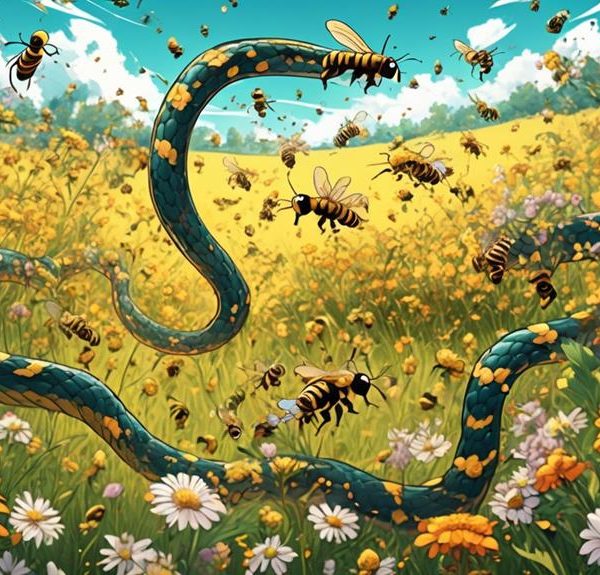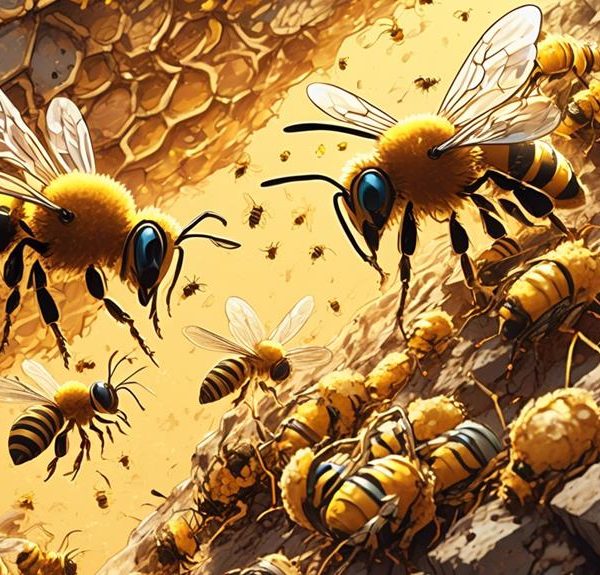Unveiling the curious case of bees and honey – could these master architects meet their end in their sweet creation?
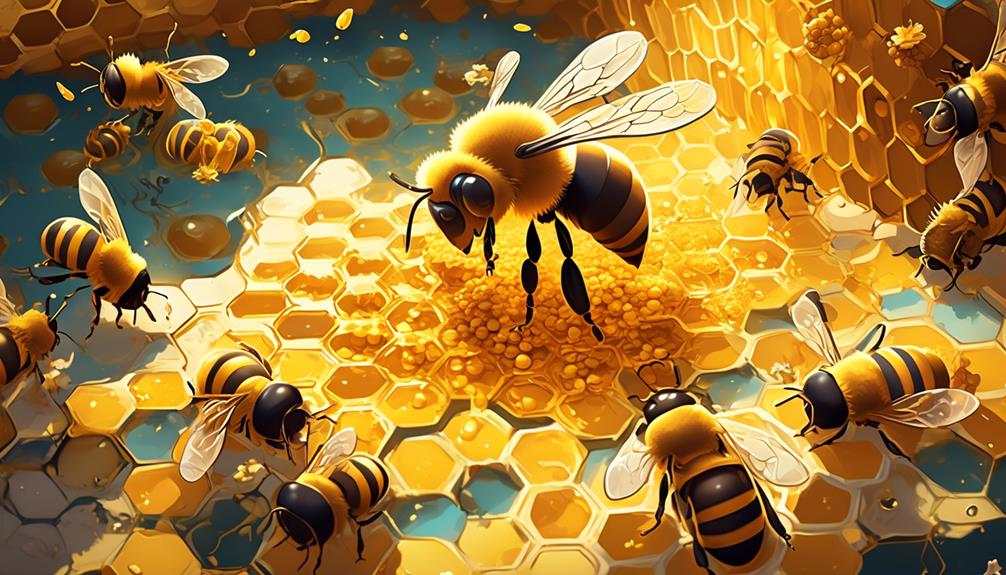
Can Bees Drown in Honey?
'You know the old saying, 'you catch more flies with honey than vinegar', right? Well, let's twist that notion a bit and consider the bees, the real architects behind this sweet nectar.
Ever pondered if the bees could meet their end in the very substance they produce? While it may seem counterintuitive, it's a question that sends ripples through the beekeeping community.
After all, bees are adept swimmers, but could they potentially drown in their own honey? It's a perplexing thought that we'll unravel, and by the end, you might find your perception of these humble creatures transformed.'
Key Takeaways
- Bees have a complex respiratory system and breathe through spiracles and tracheae.
- Honey can clog the bee's spiracles and cut off oxygen supply, leading to exhaustion of stored oxygen.
- Honey is a crucial food reserve for bees, especially during winter.
- Bees drowning in honey is rare but can occur under certain conditions such as excess honey in the hive or bee fatigue.
Understanding Bee Anatomy
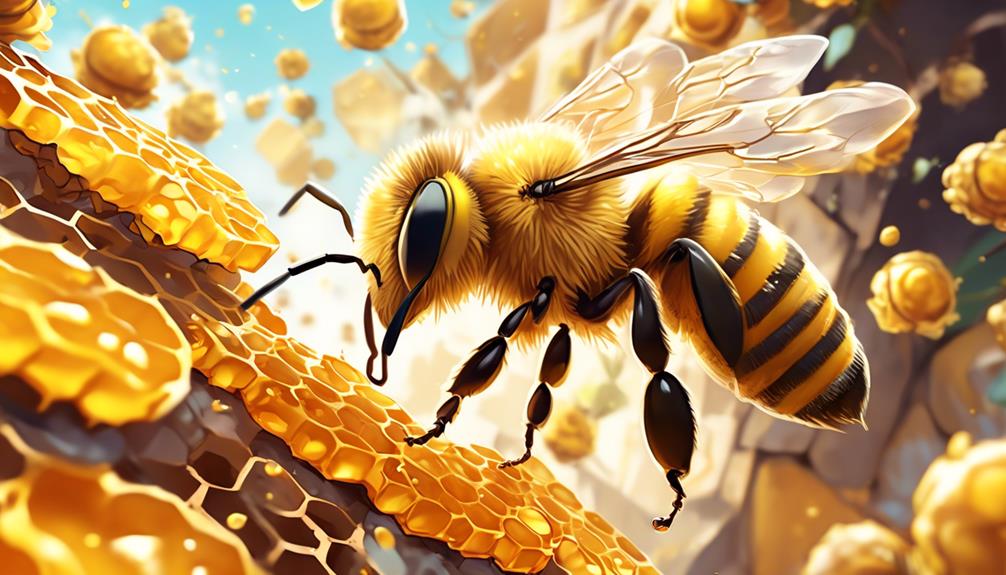
To truly grasp how a bee could potentially drown in honey, it's crucial to delve into the fascinating intricacies of bee anatomy. Bees, like humans, have a complex respiratory system. They don't breathe through their mouths, but through small, tubular structures called spiracles located on their bodies. These spiracles lead to tracheae, which distribute oxygen throughout their bodies.
Now, let's consider the bee's exoskeleton, a rigid outer layer that offers both protection and support. This exoskeleton, however, doesn't expand like human lungs do. Instead, bees have to actively pump their body to draw in oxygen and expel carbon dioxide.
Imagine a bee submerged in honey. The thick, viscous nature of honey could easily clog the bee's spiracles, cutting off its oxygen supply. Moreover, the bee's struggle to free itself may exhaust its stored oxygen faster.
The Honey Production Process
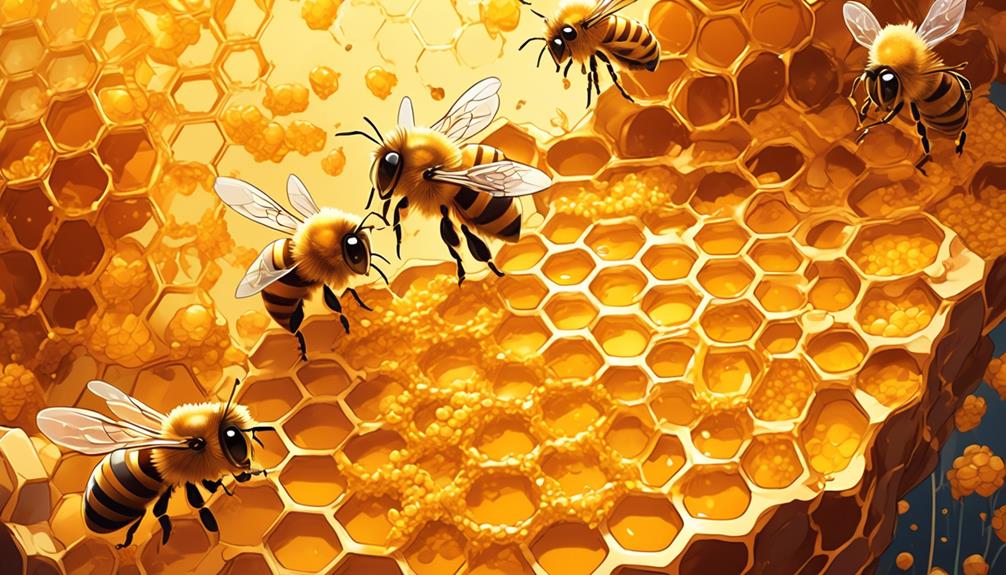
Let's delve into the five-step process that bees meticulously follow to produce honey, transforming nectar into the sweet, golden liquid we all know and love.
It all starts with foraging. Worker bees venture out, collecting nectar from various flowers. This nectar is stored in their 'honey stomachs', separate from their actual digestive stomach.
Next, they return to the hive and pass the nectar to other worker bees. This is where the second step, digestion, comes in. These bees begin to break down the complex sugars of the nectar into simpler ones, a process called inversion.
The third step involves the bees regurgitating the nectar into the honeycomb's cells. Don't be put off by the term 'regurgitating', it's essential to the process.
Next, water evaporation occurs. Bees fan their wings to dry out the nectar into a thicker substance: honey.
Finally, once the honey is ready, bees seal the honeycomb cell with beeswax, a substance they produce.
Congratulations! You've just walked through the intricate, fascinating process of honey production, a testament to the incredible industriousness of bees.
Interaction Between Bees and Honey
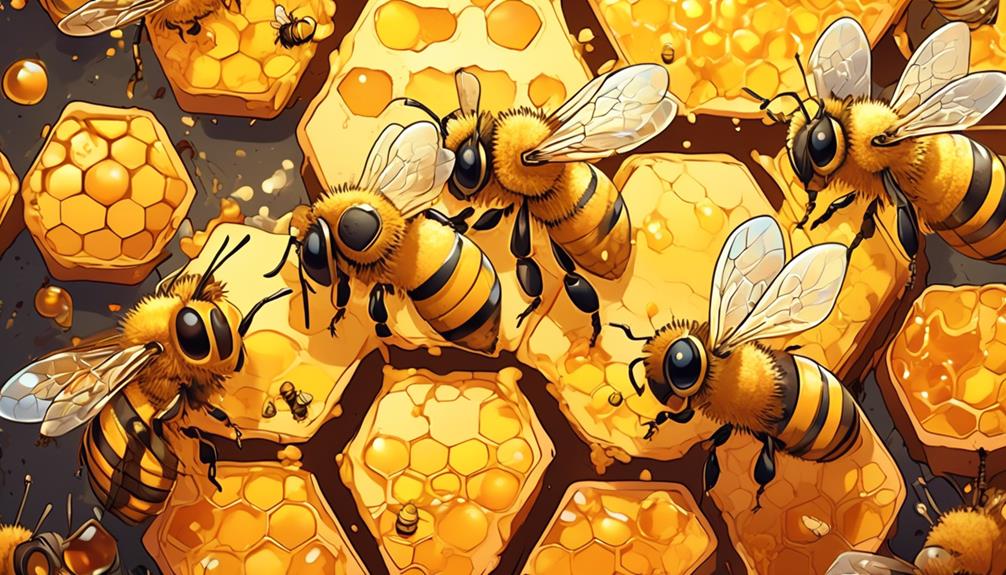
Delving deeper into the world of bees, you'll find their interaction with honey is quite remarkable and crucial for their survival. Honey isn't just food for bees; it's a lifeline, especially during winter. They store honey in combs as a food reserve when nectar, their primary food source, isn't available.
Worker bees collect nectar, a sugary liquid from flowers, and store it in their honey stomach. Back in the hive, they regurgitate the nectar to house bees, who then chew it, breaking down complex sugars into simpler ones. This mixture is then deposited into honeycomb cells and fanned by bees' wings to evaporate excess water. The final product is thick, nutritious honey, sealed with a beeswax cap for preservation.
Bees also use honey as a defense mechanism. If invaders threaten their hive, bees can engorge on honey, enabling them to stay alive even if forced to abandon the hive.
However, bees can get stuck in honey. They're not good swimmers and the viscous nature of honey can trap them, potentially leading to their drowning. Yet, bees drowning in honey is rare, as they're usually efficient at navigating their sticky surroundings.
Instances of Bees Drowning in Honey
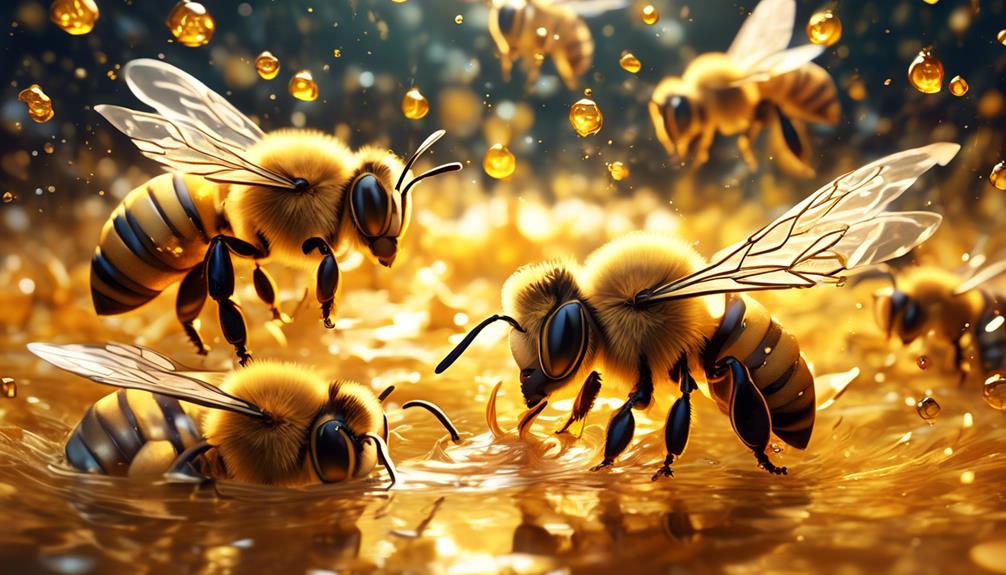
While it's uncommon due to their adept navigation skills, there have been instances where bees have unfortunately drowned in their own honey. These cases usually occur when there's an excess of honey in the hive or when the bee is physically not able to escape due to fatigue or injury.
To understand this further, let's consider the following table:
Condition | Possibility of Drowning |
|---|---|
Honey Overflow | High |
Bee Fatigue | Medium |
Bee Injury | High |
Normal Conditions | Low |
As you can see, the risk of a bee drowning in honey increases under certain conditions. An overflow of honey can make it difficult for a bee to navigate, potentially trapping it. Similarly, if a bee is injured or fatigued, it may lack the strength to escape the sticky substance.
Although honey is essential to a bee's survival, it can also pose a risk under the right circumstances. This highlights the delicate balance of nature and how even seemingly innocuous substances can become hazards. As such, beekeepers should monitor their hives closely to prevent such unfortunate incidents.
Prevention Methods for Beekeepers
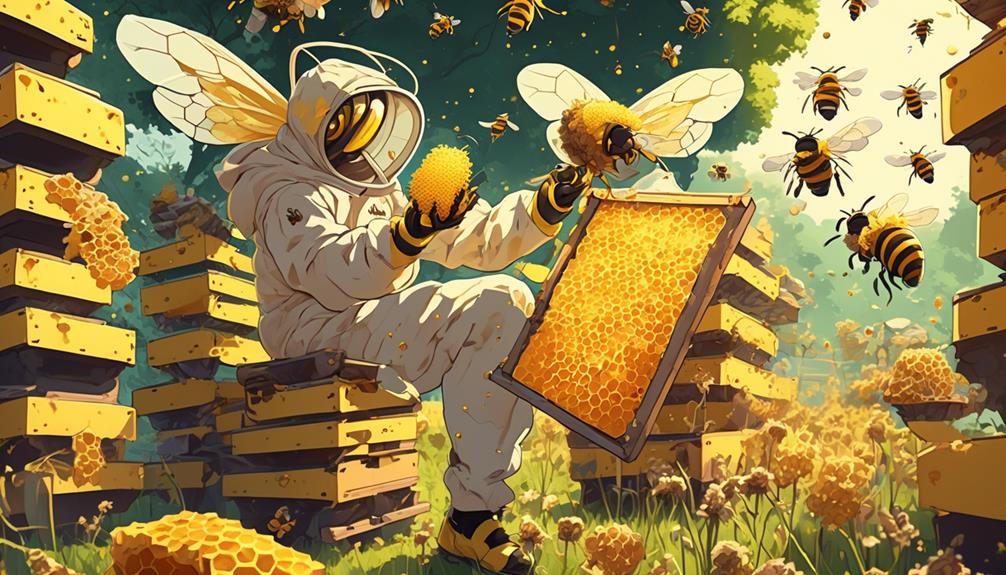
To ensure the safety of bees and prevent instances of drowning in honey, beekeepers can implement several effective strategies.
First, you should consider using a type of hive design that minimizes the risk, such as the Langstroth hive with its bee space. This space prevents bees from filling it with honey, reducing the risk of drowning.
Second, proper hive maintenance is crucial. Regularly check your hives for signs of overcrowding or honey flooding which could lead to drowning. If spotted, it's important to take action quickly. This might mean adding supers, frames, or performing a honey harvest.
Third, consider using a queen excluder. This device keeps the queen bee in the brood chamber, preventing her from laying eggs in the honey stores. It reduces the chance of bees drowning while trying to care for larvae in honey-filled cells.
Lastly, during honey extraction, be cautious. Use a bee escape board to ensure bees aren't present in the honey supers during extraction. This prevents accidental drownings.
These steps, if followed diligently, can greatly reduce the chances of bees drowning in honey. Remember, it's not just about honey production, but also about the welfare of your bees.
Frequently Asked Questions
What Are the Various Species of Bees That Produce Honey?
You're probably familiar with the Western Honey Bee, but did you know there are other honey-producing species? The Eastern Honey Bee, Giant Honey Bee, and the Dwarf Honey Bee also produce honey.
There's even a stingless bee species, like the Melipona Bee, known for their unique honey.
Can Bees Survive Without Honey?
Yes, bees can survive without honey. It's their food storage for cold months when flowers aren't blooming.
But, if nectar, their main food source, is available they don't need honey. Bees also consume pollen for protein. In a pinch, they'll eat other sweet substances.
However, it's the honey's unique composition that sustains them through winter. So, while they can live without it temporarily, in long-term or harsh conditions, it's essential.
How Does Temperature and Climate Affect the Honey Production Process?
Yes, temperature and climate significantly impact honey production.
In cooler climates, bees work harder to maintain hive temperature, which can reduce honey output. They'll also consume more honey for energy.
Conversely, in warmer climates, bees may produce more honey but quality can suffer due to rapid nectar evaporation.
What Are the Nutritional Benefits of Honey for Humans?
Yes, you can reap numerous nutritional benefits from honey.
It's packed with antioxidants that boost your immunity, and it can help with digestion.
Honey's natural sugars provide a healthy energy boost.
It's also a good source of vitamins and minerals like vitamin C, calcium, and iron.
Plus, it's a healthier sweet alternative for diabetics.
Are There Any Other Threats to Bees Within the Hive Apart From Drowning in Honey?
Yes, bees face several threats within the hive apart from drowning in honey. They're at risk from parasites like Varroa mites, which can weaken or kill them. Fungal, bacterial, and viral infections can also devastate a hive.
In addition, bees can suffer from poor nutrition if their diet isn't diverse enough. Lastly, other insects, such as ants and wasps, can invade the hive and harm the bees.
Conclusion
So, you've learned that bees can indeed drown in honey, though it's not a common occurrence.
Understanding their anatomy, the honey production process, and their interaction with honey is essential in preventing such incidents.
As a beekeeper, your role in preventing this is crucial. Keep a watchful eye on your hive, ensure the frames aren't overfilled, and maintain a healthy bee population.
Your bees will thank you.

